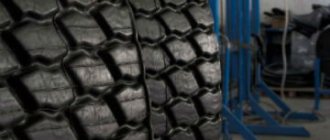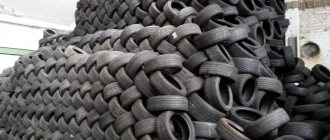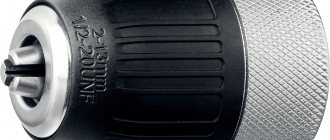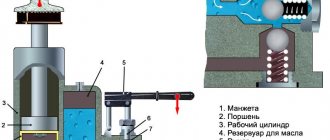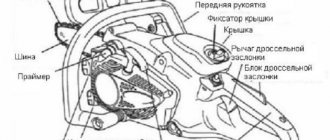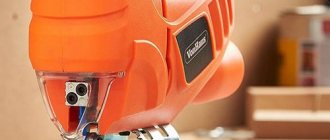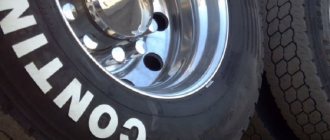With the increase in the number of road transport as a result of an increase in the volume of waste, the issue of the environmental situation has become acute. Every year, thousands of tires are taken to landfills and landfills, where they become a source of negative impact on the environment.
Car tires belong to class 4 hazardous waste due to the carcinogenic and toxic substances released during decomposition that destroy the biosphere . In recent years, waste disposal requirements in large cities have become more stringent, and compliance with rubber product recycling techniques is regularly checked.
Fire safety regulations prohibit storing tires due to the possibility of spontaneous combustion. An active person with basic knowledge of physics and carpentry skills can turn rubber waste recycling into the main source of income. Crumb rubber obtained during the recycling process acts as a secondary raw material in the manufacture of goods.
What is crumb rubber made from at home?
Crumb rubber is produced from worn-out car tires; they are more amenable to mechanical stress and the removal of metal wire (cord). Recycling waste tires allows you to obtain crumbs of the required diameter with minimal losses of raw material. Three-dimensional figures cut from tires are used as decoration in the courtyards of residential areas or garden plots. You can often find flower beds, low fences, and playground fencing made from tires.
Large-sized rubber crumbs are used to lay out the paths of private houses and summer cottages, giving them an aesthetically beautiful appearance. Play areas and sports grounds are equipped with rubber coatings with waterproofing and noise-absorbing properties.
Recycling small amounts of rubber at home
Producing a small volume of crumb rubber for personal use does not require a large amount of raw material and special equipment. You can use available tools such as scissors, a guillotine cutter or an ax. A well-sharpened knife will also work for cutting old tires.
Stages of processing tires into crumbs at home:
- cord removal
- cutting waste tires into strips
- grinding of the resulting raw material
Dealing with large volumes of rubber waste for commercial and personal purposes requires financial investment, the purchase of equipment and a facility to process the raw material. The cost of units offered by manufacturers depends on their power and configuration. Domestic and imported manufacturers provide full-cycle rubber waste recycling lines. Having basic knowledge of physics, you can make equipment for processing tires into crumbs with your own hands, meeting your personal needs.
Comparison of rubber grinding machines from Alfa-SPK
All those who have decided to start a business of processing worn rubber into crumbs are faced with the dilemma of choosing the right equipment for their enterprise. But not all equipment offered on our market will bring you real and stable income!
Choosing the wrong equipment entails:
- losses and wasted time;
- loss of your investments once and for all!
You will have to invest above the price in additional components. If the equipment “stops”, then every day of downtime is money that has passed PAST you. Low-quality equipment will not be able to provide you with high-quality crumb rubber and the required volume to recoup production costs. The issue of equipment payback will drag on for many years or you will have to forget about it altogether, not to mention the profit!
Of course, European equipment for processing worn rubber is high-quality and reliable, but the cost of this equipment (on average about 2 million euros or more) is an unaffordable amount for many beginning entrepreneurs, especially since the payback for such equipment will be more than 7 years, which, of course, becomes uninteresting and illusory in the face of growing competition and constantly changing events. And it’s not a fact that the equipment will be manufactured in Europe. For example: many well-known companies in our, European or American markets pass off their equipment as European, although they assemble it entirely in China. There are a lot of examples of such companies - manufacturers (resellers). For example, one well-known American company, which is also represented on our market, simply resells equipment from a Chinese manufacturer under its own brand. The same companies (resellers) are present on the Russian market, passing off their installations as their own and convincing that they were either assembled in Europe, or assembled by them, but with European components and so on. No matter how you twist these numerous phrases, the essence does not change. China is China, and if you decide to buy equipment from Chinese manufacturers, then buy it without numerous intermediaries who inflate more than 100 percent of the marginal profit on non-functioning equipment, without bearing any responsibility, much less a guarantee. And the breakdowns will be serious and permanent.
For greater clarity and understanding of this issue, we will analyze all the pitfalls that you may encounter when purchasing equipment.
The bulk of the equipment offered in our country includes a so-called preparatory group. Sellers explain its necessity by saying that by preparing the rubber before feeding it into the shredder, productivity increases, the knives in the shredder become less dull, and so on. All this is pure fairy tales and inventions of ignorant “professionals”! This only reduces productivity, and the knives in shredders, if they are made of the right steel, are dulled more quickly by the rubber itself than by rubber that contains a metal cord.
Returning to the preparatory group, let's consider its components:
1. Puller for metal bead ring of tires. Used to pull out the bead ring. Costs: work requires one person, additional electricity; if the unit breaks down, you cannot work on the tire processing line (it risks breaking the shredder and impact crushers). If for some reason it was not possible to pull out the bead ring, it must be cut from the tire using a grinder or a special cutting machine. The average time to tear out or trim a tire bead is about 7-10 minutes on each side.
2. Machines for cutting prepared tires into strips and chips. Used for cutting small pieces of rubber (average up to 15 cm) for feeding into the main shredder for processing. Costs: one person is required to operate the machine, additional costs for electricity and maintenance, in case of breakdown, the entire equipment stops. The average time to cut one truck wheel into the required chips is 15 minutes.
3. Guillotine shears and other additional units for cutting prepared tires into pieces. Used for cutting truck and passenger tires for easy feeding into the shredder. Costs: One person is required to operate the machine, additional electricity consumption and other consumable parts. The average time to cut one truck wheel into the required chips takes 10 minutes.
So, what do these auxiliary machines and units give you? There is only one answer - expenses, breakdowns, high production costs of the finished product and numerous costs for repairs and modernization of equipment.
The real cost of producing crumb rubber using equipment with a preparatory group is 12-13 rubles (or even higher) per kilogram, provided that this equipment is working properly. And most importantly, it is simply not realistic to process the volume of tires according to the stated characteristics! Many enterprises that operate on similar equipment work in two shifts (during the day they prepare rubber for processing, and at night they process what they prepared during the day), but even then they cannot get two tons of finished crumbs from the same 500th model. thereby earning a maximum of 3,000 rubles per day. And then only when the equipment is working properly. It is much more profitable with such profitability to work in a taxi or even as a loader, and there is nothing funny about that!
It is IMPOSSIBLE to operate such equipment profitably. Don't reinvent the wheel, look at things with real eyes, otherwise you will get what many people got. (to enlarge, click on the photo).
Equipment for grinding worn rubber from our company
In turn, we offer you actually working equipment, where the real cost of producing a kilogram of crumbs does not exceed 5.5 rubles:
— Equipment that includes only guillotine shears from the entire preparatory group, which are used only for cutting truck tires into 4 uniform parts.
— Equipment that actually employs 3 people.
— Equipment that actually processes the volume stated according to its characteristics.
— Equipment that is entirely made, developed and assembled in Russia.
— Equipment on which you can really make money, with more than 100% marginal profit!
For purchasing questions or other additional clarifications and consultations, you can contact the offices of our company by contacting us by phone or filling out the feedback form.
One of the many videos on the Internet posted by dissatisfied users who have experience working on the wrong equipment
Video presentation of our tire recycling equipment
Methods for making tire crumbs
Methods for obtaining crumb rubber:
- Cooling of raw materials with liquid nitrogen to a brittle state and subsequent grinding. This type of processing requires special freezers; the raw material is cooled to a temperature of -70 - -90 degrees and is impossible at home.
- Grinding of rubber products on specialized lines for a full processing cycle. This method is used in industrial production, where the production of crumb rubber is carried out in large quantities and requires large financial investments.
- Rubber processing at home using homemade units (crushing machines). Having milling and welding equipment, you can make a chopper with your own hands. If this is not possible, parts can be ordered from the workshop according to personal designs. The cost of a crusher made independently is much cheaper than ready-made equipment.
Regular recycling of waste rubber requires a well-ventilated and spacious area to install equipment and store large quantities of waste rubber. The location of the premises in an industrial zone will be a plus.
Making crumbs using a built grinder
When the DIY rubber shredder was ready, I couldn’t wait to use it. I found a few more old tires in the cellar and got to work. The whole procedure was a step-by-step algorithm, which I describe below:
- Visual inspection and removal of interfering parts for recycling (garbage, pieces of dirt, glass and other sources of damage). I advise you to focus your attention on this, since the presence of a foreign body can negatively affect the operation of the constructed unit.
- Cord cutting. This manipulation is also mandatory, since there is metal wire inside it, which cannot be processed in a crushing apparatus. Due to the presence of such reinforcement, the crushing machine may jam.
- Preparation of belts from tires up to 80 mm wide and their further shredding using a shredder installed in the machine.
- Separation. The process of separating the remaining metal parts directly from the rubber takes place.
- Calibration. At this stage, the finished crumbs are changed into fractions using a built-in vibrating sieve.
At this stage, the option of professional grinding into rubber crumb can be considered complete. I would like to note that after the first processing, it seemed to me that the crumbs turned out to be quite large, so I decided to pass them through the crusher again. The second result impressed me. The result was a raw material of uniform consistency.
Unit design
The design of the shredder is a knife mechanism (shredder), which allows you to process tires, tubes and other rubber elements. With this method of grinding, the material retains its molecular formula and does not lose its elasticity. The performance of equipment depends entirely on its power rating.
Main components of the rubber processing unit:
- Electric motor - ensures the speed of processing rubber waste, recommended engine power is 4-5 kW.
- Box with cutting discs - crushes raw material to the required size.
- Crumb calibration grid - regulates the diameter of the resulting crumb rubber.
- Worm gear – eliminates jamming and jamming of material.
- Unit frame - ensures a stable position of the machine.
- Loading hopper
- Guide tray
The entire mechanism of the machine is placed in a housing, on top of which a loading hopper is installed. Before loading the material, foreign metal objects (spikes, nails, etc.) must be removed. Tires are cut into strips, reducing processing time.
Box with cutting discs
The main part of the unit is a shredder unit. The box contains heat-treated steel milling discs of high strength. They are quite wear-resistant and do not require frequent replacement during operation of the machine. Manufacturing the structure requires precise calculation of holes and cutting discs, so the work should be entrusted to the designer.
Grid for calibrating crumbs
A calibrating grid is installed under the box with the milling shafts, which allows you to adjust the diameter of the crumb rubber obtained when shredding tires in a shredder.
Worm gearbox
The mechanical gearbox converts angular velocity using a worm gear and allows you to process rubber material of varying elasticity without winding or freezing. The mechanical transmission of rotational motion is set in the range from 25 to 35 units, ensuring high performance of the unit.
Unit frame
Safe operation is guaranteed by the machine frame, made of profile materials. It ensures a stable position of the unit during the period of crushing and loading of raw material.
Loading hopper
The machine is equipped with a hopper for loading tire raw materials, which for convenience is located on the upper part of the body and a guide tray. They ensure a uniform flow of raw material into the shredder (shredder), preventing the formation of congestion during operation.
Tire cutting device
To cut tires and remove metal cord, a structure of a rack and a supporting frame is used. The housing contains a bar clamping system, which rotates together with the bar during cutting. The rack of the structure is equipped with a wedge-shaped knife that can be adjusted to a specific tire size. This design installation technology saves time on preparing consumables for further grinding in a shredder.
Tire shredding
The technological process of grinding involves the following procedure:
- Sorting of tire raw materials and removal of foreign metal (nails, spikes, etc.)
- Removing metal cord
- Cutting tires into strips
- Shredding raw material in a shredder
- Calibration of the resulting crumbs
Complex method using equipment
This manufacturing option is reliable, but requires the preparation of special equipment. I did not buy equipment for grinding, since I also decided to assemble a structure from parts available on the farm. I'll tell you step by step what followed.
Detailed design of the unit
At this stage, I will explain what parts a homemade crusher should consist of and where I got them from. If you still have to buy something from the components, then believe me it will be much cheaper than purchasing an industrial device. So, the design should consist of:
- two electric motors (I took them from two old home mills, power 5 kW each);
- a housing in which disc shafts are built in (the latter had to be ordered to fit your dimensions);
- regular grille;
- worm gearbox (at least two pieces are required);
- do-it-yourself shredder frame for rubber crumbs;
- bunker for loading material for processing;
- guide channel;
- cabinet with control buttons;
- device for preparing tires for shredding;
- powerful frame for installing equipment.
The last structural element will also have to be ordered from professional welders. The frame must be made from channels. But, if you have skill in this matter, then you can think through the support yourself. Next, I propose to consider the main components of the device in more detail.
Source sell-agro.ru
Box with built-in cutting discs
This element includes a housing equipped with small milling shafts. The knives themselves, which are used for chopping, are made of high-strength steel. They also have high thermal stability, as they can become very hot during operation. Thanks to heat treatment, cutting structures last longer and do not require periodic maintenance.
Calibration grid
This DIY tire shredder design is installed directly under the rollers. It serves to obtain a calibrated fraction from processed raw materials. This element is mandatory, as it allows you to obtain a uniform mixture.
Source ad-cd.net
Worm gear
It serves for separate rotation of disk cutters. The gearbox itself is connected using couplings to the provided electric motors. To cut rubber at a sufficient speed, you will need to select the correct gear ratio - from 25 to 35.
Frame for installing the unit
The unit is installed on a durable frame, which is made by welding profile elements. It is this detail that is responsible for the stability of the structure and strength. I made this frame to order and then connected it to the working mechanism separately.
Bunker for receiving raw materials
It is made large enough so that waste from several car tires can be loaded simultaneously. The receiving tank is usually made in the form of a special cone shape. It ensures directed movement of the rubber mass towards the moving cutting rollers.
Element used for cutting
It contains a supporting frame and a stand. The frame has a clamping mechanism that ensures the rotation of the tire along with the mechanism, during which it cuts the rubber.
Source prostanki.com
I have indicated everything about the components of the device, all that remains is to assemble it correctly. Here you cannot do without the help of a designer, since it is important to understand the action plan. To be honest, after collecting all the necessary components, I entrusted the work of assembling the unit to a professional.
Recycling
Crumb rubber is widely used in various areas of production, sold to the public or used for personal purposes. An excess of worn-out car tires and rubber products ensures the constant availability of consumables.
The cost of crumb rubber depends on the diameter and quality of the granules. Powdered crumbs and granules with a diameter of 2-4 mm are in great demand. The popularity of this size is due to lower production costs and lower consumption of adhesive, the price of which is several times higher than the cost of recycled materials.
Crumb rubber is used to make the following products:
- Roll coverings
- Rubber Shoes
- Paving slabs
- Fuel
- Rubber insulation and seals
- Three-dimensional figures cut from used tires
- Paths for private houses, gardens and summer cottages
- Waterproofing and noise-absorbing coatings for children's and sports grounds
- Rubber technical products
- Asphalt mixtures
- Seamless rubber coatings
Currently, the recycling industry is considered promising for starting your own business due to low competition and growing demand for waste recycling services. Even with a small amount of work performed, the financial investments spent on equipment pay for themselves in a short time. Recycling tires in a crusher is recognized as the most environmentally friendly method of disposal, allowing you to make a profit with a small financial investment.
